#and actually shows biodiversity in the field!
Photo

(photo source)
#weirdcore#oddcore#dreamcore#i remade this image because the op of the other one was a n*zi#i reported their blog and hope they get deleted#anyways if you reblogged the other one you should delete it and reblog this instead#so that we're not spreading a hate account around#this one also uses a properly credited creative commons image!#and actually shows biodiversity in the field!#wow!#anyways here's to wishing all my jewish followers a pleasant day you are all lovely
1K notes
·
View notes
Text
against the logic of the lawn
Imagine a box.
This box is sealed with tape or adhesive, which shows you that it has never been opened or re-used. It is in pristine condition. Apart from that, the box could hold anything. It could contain a Star Wars Funko Pop, a printer, a shirt ordered from some sketchy online vendor, a knockoff store-brand cereal, six individually wrapped protein bars.
As a Consumer ("the" Consumer) this is your fundamental right: To purchase a box that is, presumably, identical to every other box like it.
When you Buy Product, it arrives in a box, entire of itself and without context. It has not changed since its creation. If and when Product does change—whether it is broken, spoiled, used up, or eaten—you can Buy Product that is identical in every meaningful way to the original.
It's okay if this doesn't make sense yet. (You can stop imagining the box now.)
Imagine instead a suburban housing development, somewhere in the USA.
Imagine row on row of pristine, newly built houses, each constructed with small, meaningless variations in their aesthetic, all with beige or white vinyl siding and perhaps some decorative brick, all situated on identical rectangles of land covered with freshly unrolled sod. This is the Product that every consumer aspires to Buy.
I am not exactly—qualified, or entitled, to speak on the politics of land ownership in this country. My ancestors benefited directly from the genocide of Native Americans, which allowed Europeans to steal the land they lived on, which is where a lot of wealth comes from in the end, even today. However, I have eyes in my head to see that the act of colonizing a continent, and an economic system that formed as a supporting infrastructure to colonization, have embedded something almost irreparably dysfunctional into the dominant American culture's relationship to land.
This dysfunctional Thing, this Sickness, leads us to consider land to be a Product, and to consider a human upon the land to be a Consumer.
From this point of view, land is either locked into this relationship of control and "use" to varying extents, or it is free of human influence. People trying to reason about how to preserve Earth's biosphere, working within this framework without realizing, decide that we must "set aside" large areas of land for "nature."
This is a naive and, I would reckon, probably itself colonialist way of seeing things. It appears to be well-validated by evidence. Where human population is largest, there is less biodiversity.
But I find the broad conclusions to be strikingly unscientific. The plan of "setting aside part of Earth for nature" displays little curiosity about the mechanisms by which human presence impacts biodiversity. Otherwise intelligent people, perhaps caught up in the "bargaining" phase of climate grief, seem taken in by the idea that the human species gives off a magical anti-biodiversity force field, as if feeling guiltier will fix the problems.
(Never mind that lands managed by indigenous folk actually have MORE biodiversity...almost like our species' relationship to the planet isn't inherently exploitative, but rather, the capitalist and colonialist powers destroying everything.......)
Let's go back to the image of the new housing development. This image could be just about anywhere in the USA, because the American suburban home is made for universal interchangeability, where each little house and yard is static and replaceable with any other.
Others have written about the generic-ification of the interiors of homes, how houses are decorated with the most soul-killing, colorless furnishings to make them into Products more effectively. (I think @mcmansionhell wrote about it.)
This, likewise, is the Earth turned into a Product—razed down into something with no pre-existing context, history, or responsibility. Identical parcels of land, identical houses, where once there was a unique and diverse distribution of life. The American lawn, the American garden, the industry that promotes these aesthetics, is the environmental version of that ghastly, ugly "minimalism" infecting the interiors of homes.
The extremely neat, sparse, manicured look that is so totally inescapable in American yards originated from the estates of European aristocracy, which displayed the owner's wealth by flaunting an abundance of land that was both heavily managed and useless. People defend the lawn on the basis that grass tolerates being walked upon and is good for children to play, but to say this is *the* purpose of a lawn is bullshit—children are far more interested in trees, creeks, sticks, weeds, flowers, and mud than Grass Surface, many people with lawns do not have children, and most people spend more time mowing their lawn than they do doing literally anything else outside. How often do you see Americans outside in their yards doing anything except mowing?
What is there to do, anyway? Why would you want to go outside with nothing but the sun beating down on you and the noise of your neighbors' lawn mowers? American culture tries to make mowing "manly" and emphasizes that it is somehow fulfilling in of itself. Mowing the lawn is something Men enjoy doing—almost a sort of leisure activity.
I don't have something against wanting a usable outdoor area that is good for outdoor activities, I do, however, have something against the idea that a lawn is good for outdoor activities. Parents have been bitching for decades about how impossible it is to drag kids outdoors, and there have been a million PSAs about how children need to be outside playing instead of spending their lives on video games. Meanwhile, at the place I work, every kid is ECSTATIC and vibrating with enthusiasm to be in the woods surrounded by trees, sticks, leaves, and mud.
The literal, straightforward historical answer to the lawn is that the American lawn exists to get Americans to spend money on chemicals. The modern lawn ideal was invented to sell a surplus of fertilizer created after WW2 chemical plants that had been used to make explosives were repurposed to produce fertilizer. Now you know! The more analytical, sociological answer is that the purpose of the lawn is to distance you from the lower class. A less strictly maintained space lowers property values, it looks shabby and unkempt, it reflects badly on the neighborhood, it makes you look like a "redneck." And so on. The largest, most lavish McMansions in my area all have the emptiest, most desolate yards, and the lush gardens all belong to tiny, run-down houses.
But the answer that really cuts to the core of it, I think, is that lawns are a technology for making land into a Product for consumers. (This coexists with the above answers.) Turfgrass is a perfectly generic blank slate onto which anything can be projected. It is emptiness. It is stasis.
I worry about the flattening of our imaginations. Illustrations in books generally cover the ground outdoors in a uniform layer of green, sometimes with strokes suggesting individual blades of grass if they want to get fancy. Video games do this. Animated shows and movies do this.
Short, carpet-like turfgrass as the Universal Outdoor Surface is so ubiquitous and intuitive that any alternative is bizarre, socially unacceptable, and for many, completely unimaginable. When I am a passenger in a car, what horrifies me the most to see out the window is not only the turfgrass lawns of individuals, but rather, the turfgrass Surface that the entire inhabited landscape has been rendered into—vacant stretches of land surrounding businesses and churches, separating parking lots, bordering Wal-Marts, apartment complexes, and roadsides.
These spaces are not used, they are almost never walked upon. They do nothing. They are maintained, ceaselessly, by gas-powered machines that are far, far more carbon-emitting than cars per hour of use, emitting in one hour the same amount of pollution as a 500-mile drive. It is an endless effort to keep the land in the same state, never mind that it's a shitty, useless state.
Nature is dynamic. Biodiversity is dynamic. From a business point of view, the lawn care industry has found a brilliant scheme to milk limitless money from people, since trying to put a stop to the dynamism and constant change of nature is a Sisyphean situation, and nature responds with increasingly aggressive and rapid change as disturbance gets more intense.
On r/lawncare, a man posted despairingly that he had spent over $1500 tearing out every inch of sod in his yard, only for the exact same weeds to return. That subreddit strikes horror in my heart that I cannot describe, and the more I learn about ecology, the more terrible it gets. It was common practice for people in r/lawncare to advise others to soak their entire yard in Roundup to kill all plant life and start over from a "blank slate."
Before giving up, I tried to explain over and over that it was 100% impossible to get a "blank slate." Weeds typically spread by wind and their seeds can persist for DECADES in the soil seed bank, waiting for a disastrous event to trigger them to sprout. They will always come back. It's their job.
It was impossible for those guys to understand that they were inherently not just constructing a lawn from scratch, and were contending with another power or entity (Nature) with its own interests.
The logic of the lawn also extends into our gardens. We are encouraged to see the dynamism of nature as something that acts against our interests (and thus requires Buy Product) so much, that we think any unexpected change in our yard is bad. People are sometimes baffled when I see a random plant popping up among my flowers as potentially a good thing.
"That's a weed!" Maybe! Nonetheless, it has a purpose. I don't know who this stranger is, so I would be a fool to kill it!
A good caretaker knows that the place they care for will change on its own, and that this is GOOD and brings blessings or at least messages. I didn't have to buy goldenrod plants—they came by themselves! Several of our trees arrived on their own. The logic that sees all "weeds" as an enemy to be destroyed without even identifying ignores the wisdom of nature's processes.
The other day at work, the ecologist took me to see pink lady's slipper orchids. The forest there was razed and logged about a hundred years ago, and it got into my head to ask how the orchids returned. He only shrugged. "Who knows?"
Garden centers put plants out for sale when they are blooming. People buy trees from Fast Growing Trees dot com. The quick, final results that are standard with Buy Product, which are so completely opposite the constant slow chaos of nature, have become so standard in the gardening world that the hideous black mulch sold at garden centers is severed from the very purpose of mulch, and instead serves to visually emphasize small, lonely plants against its dark background. (For the record, once your plants mature, you should not be able to SEE the mulch.)
Landscapers regularly place shrubs, bushes, trees and flowers in places where they have no room to reach maturity. It's standard—landscapers seem to plan with the expectation that everything will be ripped out within 5-10 years. The average person has no clue how big trees and bushes get because their entire surroundings, which are made of living things (which do in fact feel and communicate) are treated as disposable.
Because in ten years, this building won't be an orthodontists' office, in ten years, this old lady will be dead, in ten years, the kids will have grown, and capitalism is incapable of preparing for a future, only for the next buyer.
The logic of the lawn is that gardens and ecosystems that take time to build are not to be valued, because a lush, biodiverse garden is not easily sold, easily bought, easily maintained, easily owned, or easily treated with indifference. An ecosystem requires wisdom from the caretaker. That runs contrary to the Consumer identity.
And it's this disposable-ness, this indifference, that I am ultimately so strongly against, not grass, or low turf that you can step on.
What if we saw buying land as implying a responsibility to be its caretaker? To respect the inhabitants, whether or not we are personally pleased by them or think they look pretty? What creature could deserve to be killed just because it didn't make a person happy?
But the Consumer identity gives you something else...a sense of entitlement. "This is MY yard, and that possum doesn't get to live there." "This is MY yard, and I don't want bugs in it." "This is MY yard, and I can kill the spiders if I want to."
Meanwhile there is no responsibility to build the soil up for the next gardener. No responsibility to plant oaks that will grow mighty and life-giving. No responsibility to plant fruit-producing trees, brambles, and bushes. None of these things, any of which could have fulfilled a responsibility to the future. Rather, just to do whatever you damn well please, and leave those that come after with depleted, compacted soil and the aftermath of years of constant damage. It took my Meadow ten years to recover from being the garden patch of the guy that lived here before us. Who knows what he did to it.
The loss of topsoil in all our farmland is a bigger example, and explains how this is directly connected to colonialism. The Dust Bowl, the unsustainable farming practices that followed, the disappearance of the lush fertile prairie topsoil because of greed and colonizer mindset, and simple refusal to learn from what could be observed in nature. The colonizing peoples envisioned the continent as an "Empty" place, a Blank Slate that could be used and exploited however.
THAT is what's killing the planet, this idea that the planet is to be used and abused and bought and sold, that the power given by wealth gives you entitlement to do whatever you want. That "Land" is just another Product, and our strategies for taking care of Earth should be whatever causes the most Buy Product.
It's like I always write..."You are not a consumer! You are a caretaker!"
#plants#native plants#no lawns#kill your lawn#anti lawn#consumerism#capitalism#colonialism#genocide tw
2K notes
·
View notes
Text
Note: Reasons to Be Cheerful has had weirdly huge formatting issues for the past six or so months, so if that version is a mess, this link should work better.
"Florida Power & Light Company (FPL), the Sunshine State’s largest power utility, employs all the people you might expect: electricians, lineworkers, mechanical engineers — and a few you might not. For over 40 years, the company has kept a team of wildlife biologists on staff. Their task? Monitoring the giant carnivorous reptiles that reside in one of the state’s nuclear power plants.
Saving the American Crocodile
What sounds like a low-budget creature feature is actually a wildly successful conservation story. It goes like this: In 1975, the shy and reclusive American crocodile was facing extinction. Over-hunting and habitat decline caused by encroaching development had pushed its numbers to a record low. By 1975, when it was listed as endangered under the Endangered Species Act, there were only 200 to 300 left.
Three years later, in 1978, workers at the Turkey Point nuclear power plant in Homestead, Florida happened upon something that must have made them gasp: a crocodile nest along one of the plant’s 5,900-acre “cooling canals.” Rather than drive the crocs away — perhaps the easiest solution — FPL hired a team of biologists and implemented a Crocodile Management Plan. Its goal was unconventional: provide a suitable habitat for the crocs within the workings of the nuclear power plant, allowing both to coexist.
Over the course of the next 30 years, FPL’s wildlife biologists monitored nests, tagged hatchlings and generally created a hospitable environment for the reptiles. As it turned out, the plant’s cooling canals provided an ideal habitat: drained earth that never floods on which to lay eggs directly adjacent to water. Over the years, more and more crocs made the cooling canals home. By 1985, the nests at Turkey Point were responsible for 10 percent of American crocodile hatchlings in South Florida. In 2007, the U.S. Fish and Wildlife Service downgraded the American crocodile’s status from endangered to threatened, singling out FPL for its efforts.
The program continues to this day. To date, biologists have tagged some 7,000 babies born at the plant. In 2021, there were a record-setting 565 crocodile hatchlings at the Turkey Point facility.
"Reconciliation Ecology"
Turkey Point’s efforts are an example of what is known in the conservation world as “reconciliation ecology.” Rather than create separate areas where nature or animals can thrive in isolation from humans, reconciliation ecology suggests that we can blend the rich natural world with the world of human activity. Michael Rosenzweig, an emeritus professor of ecology and evolutionary biology at the University of Arizona, was a leading force in establishing this concept. The author of Win-Win Ecology: How the Earth’s Species can Survive in the Midst of Human Enterprise, Rosenzweig has pointed out that although human encroachment has typically been considered a threat to biodiversity, the notion that the world must be either “holy” or “profane,” ecologically speaking, is simply not true.
“In addition to its primary value as a conservation tool, reconciliation ecology offers a valuable social byproduct,” writes Rosenzweig in his first chapter. “It promises to reduce the endless bickering and legal wrangling that characterize environmental issues today.”
-via Reasons to Be Cheerful, May 5, 2022. Article continues below. All headings added by me for added readability.
Dr. Madhusudan Katti, an associate professor in the Department of Forestry and Environmental Resources at North Carolina State University, was inspired by Rosenzweig when he did his postdoc at Arizona State. Katti has now been in the field of reconciliation ecology for two decades and teaches classes on the subject. “To me it’s finding solutions to reconciling human development with biodiversity conservation,” Katti says.
This common ground between development and conservation can be consciously planned, like FPL managing a crocodile habitat at a nuclear power plant or the state-sponsored vertical gardens and commercial farms on high-rise buildings in Singapore. Other examples include the restoration of the coral reef around an undersea restaurant in Eilat, Israel, or recent legislation in New York City requiring patterned glass on high-rise buildings, making windows more visible to migratory birds. Other planned examples of reconciliation ecology can be more individually scaled: a rooftop garden in an urban setting, modifying your garden to earn a “backyard bird habitat” certification from the Audubon Society, or even just mowing your lawn less often...
Reconciliation Ecology: Nature's Already Doing It Without Us
But there are countless examples of “accidental” incidents of reconciliation ecology, as well. One of Katti’s favorites is the kit fox of California’s San Joaquin Valley. “The kit fox was one of the very first species listed on the Endangered Species Act,” Katti says. Its decline was caused by habitat loss through agricultural and industrial development, as well as the extermination of the gray wolf population, which led to an increase in coyotes. So kit foxes adapted and moved to new habitats. One of these was the city of Bakersfield, California.
“Bakersfield, surrounded by oil pumps, would be the last place you’d expect to find an endangered species,” Katti says. But researchers think kit foxes have migrated to Bakersfield because they actually have more protection there from predators like coyotes and bobcats. “The kit foxes have figured out that if they can tolerate the human disturbance and live with people, then they are safer from all these other predators,” he says.
Living in the city has led to some interesting behavioral changes. In the wild, for instance, a female kit fox gives birth to her young and raises them by herself in a den. But in the city, researchers have observed multiple females raising their litters together in the same den. “It’s like a form of cooperative breeding,” Katti says. “That wouldn’t happen in the wild.” ...
The Big Picture: How We Think about Conservation
Reconciliation Ecology isn’t just we humans welcoming animals like crocodiles and foxes into our environments, though. It’s also living with nature in a way that most Western societies haven’t done since the Enlightenment. “In recent years, there’s been a recognition that the ‘fortress conservation’ model — keeping nature separated from humans and not thinking of or valuing human-inhabited landscapes — those ideas are outdated,” says Katti.
In fact, in Katti’s classes on reconciliation ecology, he embraces the notion of reconnecting people with their land if they have been unjustly separated from it. “The term reconciliation also applies to all the colonial legacies where both nature and people have been harmed,” Katti says. “For Indigenous communities, the harm done to ecosystems, it’s happened together. So you can talk about addressing both. That’s where a lot of my thinking is at the moment.”
A hopeful version of this sort of reconciliation is happening in California where colleagues of Katti’s who are tribal members are re-introducing “tribal burns” in some areas. Controlled burns have been a part of many Indigenous cultures for millenia, both as a way to prevent devastating forest fires, but also to encourage the growth of certain plants like hazel that are used for basket-weaving and other crafts.
“The notion that people don’t belong there and ‘let nature take care of itself’ doesn’t really work,” Katti says. “That’s the legacy of Western European Enlightenment thinking — a divide between human and nature. That is a real faulty view of nature. People have been part of the ecosystem forever.”
-via Reasons to Be Cheerful, May 5, 2022
#a bit older but still ongoing/relevant and still very cool#florida#crocodile#reptile#ecology#environment#sustainability#endangered species#united states#california#kit fox#nuclear power plant#reconciliation#colonialism#the enlightenment#conservation#human beings#good news#hope#urban ecology
1K notes
·
View notes
Text
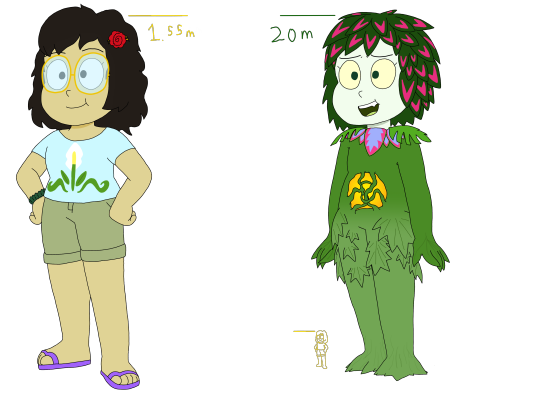
Erika Kinokami
First post of the Godzillaverse that I like to call Biola: Monster Genesis! For a start, who better to show off than the "series'" main protagonist and namesake of this gojiverse, Erika Shiragami Kinokami
Born 2009 to Genchiro Kinokami of the Typhon organization, an organization dedicated to the study of the giant organisms known as kaiju, she was already a genetic test from birth, having genes from multiple plants in her genome as a test run of giving humans photosynthetic capabilities (as a result, her skin has a bit of a greenish tone). Other than the photosynthesis and her lifelong friend being a robot⏤an AI-driven prototype of the Tezcatlipoca unit (T-units for short) technically designated as RD-A10N3 but given the name Jet Jaguar from Erika mispronouncing the Aztec deity's name⏤her life was fairly normal... until very recently.
While out on the field in a military effort against both a particularly aggressive hive of the giant neuropteran Meganula and a mated pair of volant kaiju given the name "Rodan", Erika (and Martin, an upstart kaiju-themed influencer tagging along) ran afoul of a Meganula larva within the cave systems being explored. The insect struck Erika in the abdomen with its claw, grievously wounding her. The Meganula would've killed her after that had it not been for the third Rodan, a smaller, sneaky male resembling a female, breaking through the wall and piercing the Meganula with its long, barbed tongue. For a split second, it looked to see the two other small creatures in there, but then had its attention grabbed by the controlled eruption of the nearby Mt. Aso where the Rodans had nested. As the "Faeder Rodan" flew off to try and save its mate. Jet Jaguar arrived and carried Erika off to safety.
After being brought to a Typhon facility on the remote Odo Island, Erika then undergoes a radical new treatment to help save her life. She's treated with an experimental kind of stem cell therapy incorporating cells and DNA from a kaiju whose emergence nearly 70 years ago spurred the formation of Typhon the following year; a kaiju whose power made it only deserving of the title "King of the Monsters". That beast's healing properties mean that Erika Kinokami now had a third genetic component: Gojira. After waking up, Erika seemed pretty fine at first (besides her not needing glasses anymore, being able to see ultraviolet light, and the healed up wound resembling plant resin), but she would be kept there to make sure there weren't any side effects. The next day, Erika was feeling a bit restless, and Jet suggested they go out and walk for a bit as some nature therapy. It was nice and they even found a cave system with 100% less maneating insects and plenty of nest subterranean biodiversity… but then the irradiated GNA (Godzilla DNA) really started kicking in.
Erika felt nothing at first, but then Jet pointed out that her face was getting pale and even a bit greenish. Erika dismisses that comment at first before Jet adds a small little elaboration: he means greenish even compared to her normal, chloroplast-infused skin tone. Then seeing a more vibrant green creeping up her arms, Erika bluntly agrees that they need to go back Now, and they make off. As they make their way to the cave entrance, Erika not only has leaves sprouting from the base of her neck and her hips (her hair was also gradually melding into leaves), but she starts growing from her human height of 5'1" (155 cm). Once they're at the cave entrance, she was actually too big to fit through, but ended up breaking through the entrance from her growing too big for it, finally stopping at a final height of 20 meters (and also giving a scream of terror and confusion afterwards). Jet, of course, called for help and Erika's dad and other Typhon personnel arrived. She was then brought back to the facility and later filled in on the whole GNA situation, but not before another party came by from the other side of the hill the cave entrance was on: Godzilla.
Strangely (although the maser tanks and other military units brought in preparation for the detected approach of another kaiju were hidden in the forest), the 50-meter dinosaur was noticeably unaggressive for the encounter, walking up to Erika, closely observing her with some minor vocalizations, and then leaving.
For Erika, the experience was even stranger. To her, Godzilla's face looked perplexed, showing more emotion than any photos or video footage of the Monster King she had seen before this day, and she could have sworn she heard a voice coming from him... a voice that called her a... "Biollante"?
#amber's post#my art#Biola: Monster Genesis#kaiju#godzilla#erika shiragami#biollante#yes I did change her last name from Shiragami to Kinokami which is Japanese for “tree deity”
7 notes
·
View notes
Text
Unit 10 Blog
Prompt: Describe your personal ethic as you develop as a nature interpreter. What beliefs do you bring? What responsibilities do you have? What approaches are most suitable for you as an individual?
Last blog post! Crazy to think that this semester is already almost over. I feel like these blog posts have been a good tool to supplement the learning that we did in the course. I've really enjoyed reading everyone's perspectives week by week, and definitely learned a thing or two by doing so.
As someone who's deep in the environmental sciences and seeks to pursue a career in this field, I feel as though I have strong personal ethics. In this line of work, you need to have strong convictions as environmental issues are deeply nuanced and are not as black-and-white as some other disciplines may be. From an ecological point of view, I truly believe that everything is connected and that everything has consequences if things go off-kilter. Even if we can't see it with our naked eye, I can assure you that the implications of anthropogenic changes can ripple through ecological relationships on an individual, population, community, and ecosystem scale.
I really dislike human-centric thinking in which changes in the environment don't matter unless they affect us, whether that be morally, economically, or politically. We as humans have to advocate for things that can't voice their opinions. I don't think that people realize how complex nature really is unless they strive for a career in the environmental sciences. I think the public school curriculum does a disservice in this regard, as they put more emphasis on fields with more profitability. It's surprising to me how out of touch some people are with their environment. I know people who can't identify native Ontario flora and fauna, which is essential to forming a connection with your environment. A mutual friend of mine hasn't even been to the Arboretum up until very recently in his 4 years of undergrad.
I also believe that at its core, environmental education should have no barriers. Children who grew up in urban environments deserve to experience nature at its peak-- not between cracks in sidewalks or confined in a concrete prison. Western science has been and still is dominated by cis-white men who have a very distinct view of what this looks like within an environmental context. We need to encourage other demographics to participate in academia to fill in knowledge gaps that may have not even been realized. In the same vein, I think that understanding Canada's colonial history is vital when considering knowledge gaps. Many Indigenous people are stewards of the environment, participating in guardianship programs to keep biodiversity intact. They also have a breadth of knowledge about the environment since time immemorial. Creating safe and equal opportunities in the name of conserving our planet is essential. I cannot stress that enough.
As I mentioned in previous blog posts over the weeks, I worked this summer as a camp counselor at a farm. I was the only counselor who had a background in environmental science despite camp programming being heavily focused on agriculture and nature. When working there, I often felt as though it was my duty to instill environmental education in the children. I wanted them to be inspired just like I was at their age with science. I frequently brought in my own resources (books, crystals, fossils) to show the campers and to ignite this curiosity.
Touching on the subject of accessibility again, I find that this is a big issue with scholarly journal articles. Personally, I don't think science should be put behind a paywall. Everyone has a right to understand the world around us. I also realize that most academics don't have a say in the monetary aspect of their papers and that the problem lies with the publisher. I'm probably approaching this with some naivety or ignorance due to my lack of knowledge of actually being in that world but, I still feel like my argument holds some merit. Today, so many people are still climate change deniers. When approaching this problem, I definitely think that open-access papers can help with this. People fear what they don't understand.
As a side note, I think that how science is presented in the journal articles itself should be rethought. I'm in a lab and fieldwork course right now where we're basically going through the motions of writing our own research paper. We were heavily discouraged from using synonyms, or really any interesting language. As an academic, I understand why this is. You have to be objective in order to clearly communicate the purpose of your paper. However, as a writer, this frustrates me. You could argue that journal articles are a tool of interpretation itself. Then, shouldn't we approach the methodology of writing papers differently? People whose brains are not wired for science might not even seek out articles about things they're unsure about because of the language barrier. Most people do not have the privilege of attending higher education and have to resort to media outlets that create outrageous/fear-mongering headlines in a subpar attempt at interpretation? Why does there need to be this middleman who profits from falsities and has their own biases?
Everything I've discussed in this blog post are beliefs I hold close to my heart. Without them, I don't think I'd be much of an ecologist or for that matter, a nature interpreter. I don't think we should conform to the way things have always been or approach the climate crisis with apathy. Things have to change. And the only way this can happen is through modes of interpretation. I think this post is a culmination of everything I bring to the table as an interpreter but that doesn't mean I'm right. That's the beauty of interpretation as well, there are always ways to improve, and there are always new perspectives or experiences that should contribute to the conversation.
2 notes
·
View notes
Text
Unit 9 - Desire Paths
To me, one of the most amazing things about nature is how it endlessly morphs around the impacts of the beings that interact with it. Animals, when traveling short or long distances, have the uncanny ability to not only navigate to where they want to go but to do so in the shortest, most efficient way (Borneman, 2021). The desired paths of human and non-human animals are always shorter than the built environment’s official route (Borneman, 2021). There's actually a name for this path: A Desire Path. Who would've seen that name coming? There are a few other names for it that you may be more familiar with: desire lines, cow paths, pig trails, social trails, bootleg trails, and even elephant paths (Borneman, 2021).

The image describes a desire line versus an expected path (van der Aalst, 2014).
Desire paths are created by creatures who intuit the best way to get where they want to go from where they are right now (Borneman, 2021). These paths are a method of communicating an efficient way to get from one place to another in the shortest amount of time. Just as it is used now, it would have the same purpose historically between groups to show the easiest route toward resources and shelter.
Urban planners must take into consideration the quickest route that their patrons take and incorporate this into the design of the local landscape. A very interesting example is the Oval at Ohio State, as seen below.
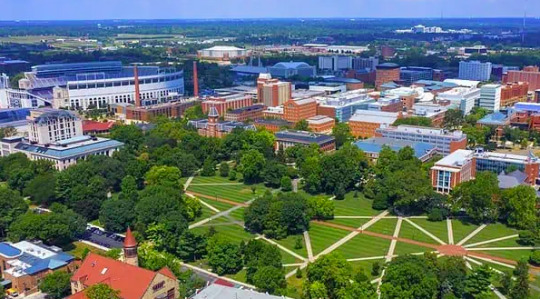
The image shows desire lines across Ohio State (Borneman, 2021). Those lines aren't random! They're the product of desire paths being taken into account! Enough students would walk across the field to get to different buildings, and eventually the university created sidewalks in the most prevalent desire paths.
There are a lot of benefits to the approach of incorporating desire paths into urban structures: a neater appearance by making sidewalks, easier route for patrons (such as those with physical disabilities) because these paths are now "official" and can be paved/iced during the winter, and so on. However, there are downsides as well.
The network of social trails can become large and convoluted and, in some areas, fragile habitats and ecosystems could be at risk because of the network of informal trails that people create themselves (Borneman, 2021). The only solutions are barricades or fences, but these oftentimes are ignored. You can see these often in parks and forests where people choose the more efficient route up winding trails (image below). Even though it's faster, cutting corners disturbs local ecology in unsustainable ways (Borneman, 2021).

The image shows a barricade across a desire path (Borneman, 2021).
I hypothesize that we can actually use our innate skill of creating desire paths to help urban planners. Imagine if we create an accurate, geographical map of a city and put ants into it. Ants would likely carve out the most efficient path, and we can use this information to create neighborhoods and public transport (buses, subway). Do you think this would work? What are some factors that this method wouldn't account for? I think one challenge would be that we may not be able to account for environmentally sensitive landscapes, like wildlife hotspots, and although desire paths may overlap with these spaces, we still need to protect them.
We should work together with nature by incorporating our natural efficiency skills to help urban planners create sustainable cities. But at the same time, we need to use our powers for good by knowing that we should avoid trampling vegetative areas that are important for biodiversity!
Borneman, E. (2021, November 29). What are desire paths? Geography Realm. Retrieved March 14, 2023, from https://www.geographyrealm.com/what-are-desire-paths/#:~:text=Desire%20paths%2C%20as%20the%20name,the%20paved%20routes%20in%20place.
van der Aalst, W. M. (2014). Desire Lines in big data. Encyclopedia of Social Network Analysis and Mining, 351–364. https://doi.org/10.1007/978-1-4614-6170-8_396
2 notes
·
View notes
Text
DONKEYS, MULES AND SHETLAND PONIES
Located in the south east of the UEA campus, behind the lake, is a field of animal pens that is home to a number of donkeys, mules and shetlands ponies (as well as the occasional rabbit or fox sleeping in the grass). Below is a ma illustrating where to find them, and a couple showing the shetland ponies:
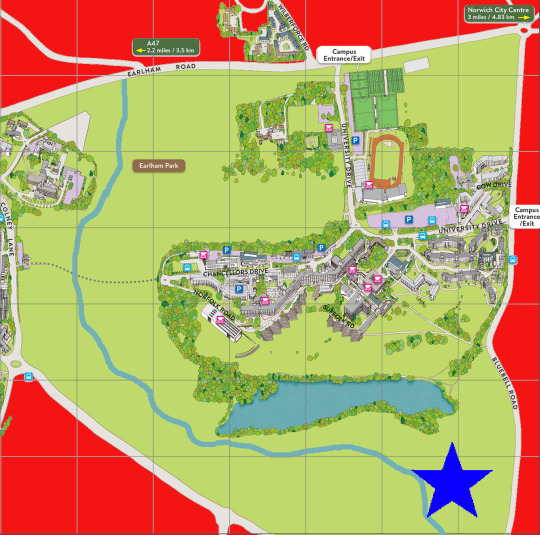

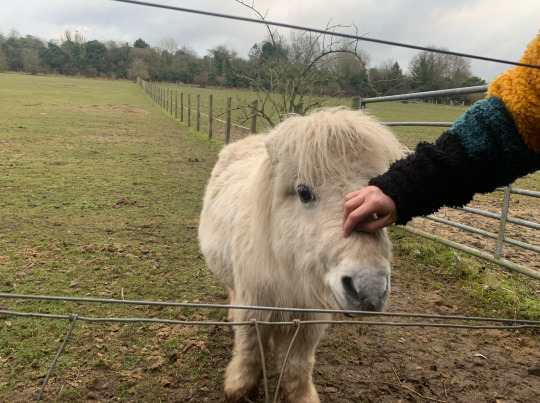
These pens are actually an animal sanctuary for the animals that live there, having most likely been abandoned or mistreated. However most are happy enough to say hello, just as long as you bring a carrot or two.
Shetland ponies are a Scottish breed of pony (Equus ferus caballus) that originate from the Shetland Isles, hence their name. Their short stocky bodies and thick coat made them very useful as pack animals, as well as to drive and ride. Miniature Shetlands have even been trained as guide horses, who perform the same role as guide dogs. The sad fact about these cute little guys are how mistreated they are nowadays in this country. They are often neglected or outright abandoned due to being purchased in haste, rising costs, and having no resale value. In the wild they are evolved to walk very long distances, so when they are kept as pets they have a tendency to become obese, which takes away their perceive aesthetic pleasure to the owner. Also in their own pen are the mules:

Mules are a domestic hybrid, born from a male donkey (known as a jack) and a female horse (known as a mare). Due to this hybridisation, a mule has 63 chromosomes, which in most cases make them infertile. Mules have been traditionally used as pack animals, due to its endurance and ability to carry up to 20% of its body weight, but are also bred around the world for meat. They have been bred and used in these ways since before 1000BC; a painting in the Tomb of Nebamun (shown below), which is dated around 1350 BC, shows a chariot being drawn by (supposably) mules:
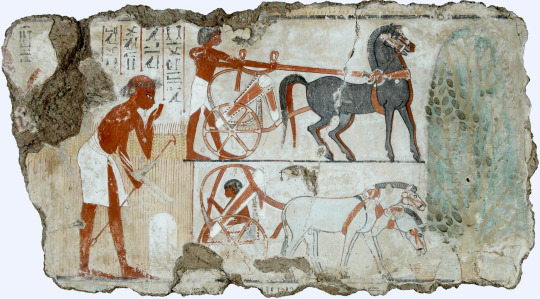
Nowadays, mules are still used worldwide as working pack animals, or pulling carts through markets. This is because they tend to live longer than horses whilst requiring less food, They can sense danger better and are more cautious than horses or donkeys, making them safer to ride across rocky, dangerous terrains. In the UK they have traditionally been used in mule rides for tourists on the beach. Here at the sanctuary, they are very wary of people, and only the sight of a full carrot is enough to gently coax them over. In the next pen we find their biological halves, the donkey:
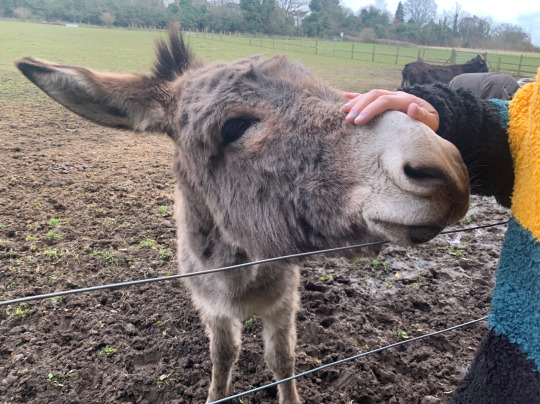
Obviously similar to mules in many ways, donkeys are also used worldwide as pack or draught animals. Over here, in the species-rich grassland of The Weston Valley, donkeys have been used to graze, similarly to the cows in Marston Marsh in Norwich. Using donkeys to graze, rather than machinery, increased the species diversity because they take out the coarser, dominant species the could outcompete or outshade smaller herbs and fine grass, as well as wildflowers. They enjoy eating these thick, woody (and even prickly, like Eeyore) species, so are pros at controlling shrub species that can encroach and kill wildflowers. Its a win-win for the donkeys too as they tend to get better nutrition than in a single-grass paddock, as the woody vegetation tends to have lower sugar levels and more fibre. According to The Donkey Sanctuary, who tend to the donkeys at The Weston Valley, if allowed to graze and more around a large area freely, donkeys will leave behind grasses of varying heights and structures, creating a range of conditions for species to establish and thrive, creating more biodiversity - again like the cows of Marston Marshes!
0 notes
Text
Adding spatial gene term and breasts tumour morphology by means of heavy mastering
These two difficulties work as minimal diagnostic possibilities have got inhibited our capability to realize lymphedema development, and also the deficiency of known fundamental components involved in the condition forbids the development of brand-new analytic targets. This kind of evaluation will serve to talk about the current developments throughout scientific and lab investigation adjustments of equally lymphedema analytical technologies and also our comprehension of your components generating ailment risk and further advancement. We're going to demonstrate exactly how these collections regarding analysis are synergistically working with the ultimate purpose of improving patient selleck chemicals outcomes for all those being affected by this particular terrible condition, figuring out important aspects of additional research that are justified to advance the field forwards and still provide clinical reduction with this ignored individual populace. (C) 2015 Elsevier Limited. Just about all protection under the law set-aside.Aims: The goal of these studies ended up being measure the biodiversity of Aspergillus area Nigri populations via Argentinean vineyards by morphological, toxigenic as well as AFLP investigation. Materials and techniques: 400 and also thirty-eight strains have been singled out via vineyard through 2006/07 along with 2007/08 vintages. The particular morphological identification as well as toxigenic profile for those traces singled out were performed. Eighty-eight stresses were chosen pertaining to characterization in types stage simply by AFLP markers. Chaos investigation demonstrated an obvious divorce into a number of main groupings: The. carbonarius, Any. tubingensis, The. niger 'aggregate' as well as Aspergillus 'uniseriate'. The. carbonarius stresses constituted the homogeneous party, although a high degree of hereditary selection was discovered within the Any. niger 'aggregate' and 'A. uniseriate' groupings. The actual A. tubingensis cluster had been the most prevalent group and it was evidently separated coming from a. niger 'aggregate'. Ten strains confirmed 45% homology using a. tubingensis FRR 5720 ex-type strain as well as have been regarded as 'atypical' or a tightly related varieties. AFLP benefits show which no genotypical distinctions can be established involving ochratoxigenic and nonochratoxigenic traces. Conclusions: Aspergillus section Nigri numbers upon watermelon had been symbolized largely by 4 teams. Any. tubingensis varieties had been separated from A. niger 'aggregate' team and several of these ranges developed OTA. Significance and Affect from the Research: This research provides brand-new information about molecular portrayal associated with Aspergillus part Nigri numbers inside Argentina.Consolidated bioprocessing (CBP), that integrates molecule manufacturing, saccharification and also fermentation in to a one method, can be a promising way of efficient ethanol generation via lignocellulosic supplies as a result of causing lowering of tools, the actual substrate and also other raw materials along with generality associated with procedure. CBP uses a remarkably manufactured bacterial tension able to hydrolyzing bio-mass together with enzymes developed by itself as well as creating high-titer ethanol. Just lately, heterologous manufacture of cellulolytic nutrients continues to be sought with yeast website hosts, which has noticed immediate alteration regarding cellulose to be able to ethanol. Exclusively, the development of mobile area engineering, which gives a display of cellulolytic digestive enzymes about the yeast mobile floor, allows for effective bio-mass hydrolysis concomitantly using ethanol creation.
#FDA-approved Drug Library#MEK inhibitor#Raf inhibitor#GSK3326595#PGE2#YC-1#Chidamide#AMD3100#MLN7243#ARN-509#E64d#CIL56#IPI-549#666-15#TG101348#ORY-1001#ONC201#FTY720#ODM-201#STZ
0 notes
Text
Wood-eating clams use their feces to dominate their habitat
https://sciencespies.com/nature/wood-eating-clams-use-their-feces-to-dominate-their-habitat/
Wood-eating clams use their feces to dominate their habitat
Deep beneath the waves, tiny clams with shells usually about as big as a pea bore into pieces of sunken wood. The wood is food for them, as well as a home. These rare, scattered, sunken pieces of wood support miniature ecosystems where different wood-boring clam species can live in harmony for years. But in a new paper in Marine Biodiversity, researchers found that one group of wood-boring clams has evolved a unique way to get the wood all for itself: building chimneys made of poop.
“There are two challenges every sea creature has to face: getting pure water in, so you can get oxygen to your gills, and getting rid of your waste. Because nobody wants to live in their poop. But here are these clams living with theirs, and actually thriving,” says Janet Voight, Associate Curator of invertebrate zoology at the Field Museum and the study’s lead author.
Scientists can put wood on the seafloor, return months or even years later, and recover it with “an amazing array of animals,” says Voight; other times wood that has been submerged for the same amount of time comes up so gnawed and bored-through that you can crumble it in your hand. This difference was a mystery, and Voight wanted to know why.
She took stock of the wood-boring clam species present in reports of sunken wood from all over the world, and she noticed a pattern. “There are six main branches in the wood-boring clam family tree, and every woodfall that was bored so heavily it was crushable by hand turned out to have been bored by a species from the same single branch of that family tree,” says Voight. She says she was surprised by this finding — “that’s not supposed to happen, you just assume that all wood-boring clam species, which tend to look pretty similar, bore into wood the same way. And yet, here’s one group that’s doing something totally different.”
Scientists had suggested that the extra-chewed-up wood was due to lots of larvae happening to be present nearby, or warmer water temperatures, but it turns out, the very nature of the clams may be responsible. Voight noted all of these extra-efficient, related species have a common trait where the sun don’t shine. As the clams dig and move into their boreholes in the wood, they fill the space around them inside the holes with their own feces.
“They don’t do it on purpose, their anatomy makes them do it,” says Voight. “When these clams bore into wood, their little shell does the boring.” Meanwhile, the clams’ siphons, tubular appendages for taking in water to get oxygen and expelling waste, stick out behind them. “In most wood-boring clams, these two “in and out” siphons are equal in length and stick out into the water column,” says Voight. “But in these related hyper-nasty borers, the siphon for expelling de-oxygenated water and feces is short; it stays inside the borehole in the wood. As a result, says Voight, “they poop in their borehole. They just have to, unless they really, really push.” The waste stays right there with the clam, forming a chimney that wraps around the siphon.
That animals would evolve an anatomy that keeps them in such close contact with their own waste, is surprising, says Voight: “It sure isn’t very hygienic, and yet they show no evidence of immune problems. They’re healthy, they’re clearly going to town on the wood. So why did they evolve this way?”
She and her colleagues hypothesized that these fecal chimneys might cue larval settlement: that their free-floating larvae might be able to detect the poop and make their way to it to make a home alongside members of their own species.
But that still leaves the problem: even if a poop chimney serves as a beacon for other members of their species to join them on their wood, how can these individuals survive as more and more larvae settle and the environment becomes filthier and oxygen becomes less available?
“This group of species of clam has been shown in previous studies to be unusually tolerant of low oxygen,” says Voight. They also have additional adaptations, like a mucosal lining of their fecal chimneys, and a substance like hemoglobin in their blood that picks up more oxygen; both may reduce the risk of sulfide poisoning from the waste. Taken together, these adaptations allow these speciesto survive in conditions that would make non-related wood-boring clams sick. The end result is more wood for the chimney-producing species to eat, live in, and for their offspring to settle on, unbothered by competitors.
Beyond just solving the mystery of the gross chewed-up wood with an even grosser solution, Voight says that the study illustrates the importance of looking at ecology with an understanding of how different species are related to each other.
“When you’re confronted with something that seems enigmatic, sometimes you need to step back and look at the big picture, put a lot of different studies together, to see how what had appeared to be enigmatic is a product of evolution,” says Voight. “Having a good family tree can help reveal patterns, and the more we know about the evolutionary histories of these different groups, the more we’ll be able to find out about how they fit together.”
#Nature
0 notes
Text
Michigan bee study: Both habitat quality and biodiversity can impact bee health
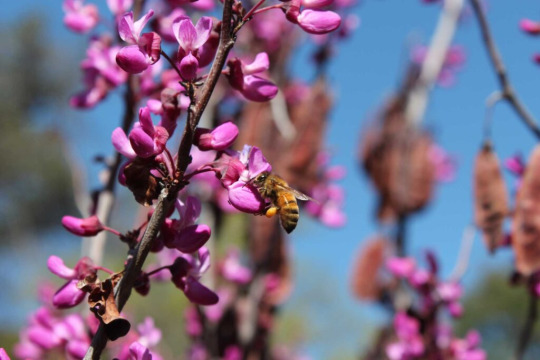
Efforts to promote the future health of both wild bees and managed honeybee colonies need to consider specific habitat needs, such as the density of wildflowers.
At the same time, improving other habitat measures—such as the amount of natural habitat surrounding croplands—may increase bee diversity while having mixed effects on overall bee health.
Those are the key findings from a new analysis of several thousand Michigan bees from 60 species. The study looked at how the quality and quantity of bee habitat surrounding small farm fields affects the levels of common viral pathogens in bee communities.
“Future land management needs to consider that broadly improving habitat quality to benefit pollinator community diversity may not necessarily also benefit pollinator health,” said University of Michigan biologist Michelle Fearon, lead author of a study published online Nov. 30 in the journal Ecology. The other authors are from U-M and the University of Washington.
“To promote pollinator health, we need to focus on improving specific habitat quality features that are linked to reducing pathogen prevalence, such as planting greater density of flowers,” said Fearon, a postdoctoral fellow in the Department of Ecology and Evolutionary Biology.
Bees are indispensable pollinators, supporting both agricultural productivity and the diversity of flowering plants worldwide. But in recent decades, both native bees and managed honeybee colonies have seen population declines, which are blamed on multiple interacting factors including habitat loss, parasites and disease, and pesticide use.
As part of the work for her U-M doctoral dissertation, Fearon and her colleagues netted and trapped more than 4,900 bees at 14 winter squash farms in southeastern Michigan, where both honeybees and wild native bees pollinate the squash flowers.
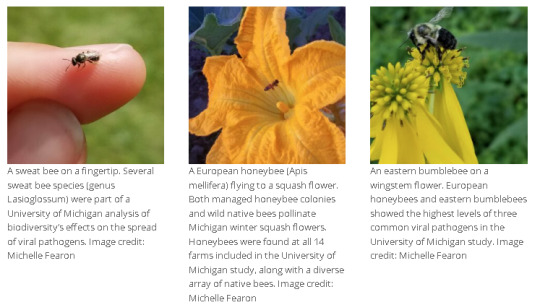
The bees were analyzed for the presence of three common viral pathogens. Consistently, lower virus levels were strongly linked to greater species richness, or biodiversity, among local bee communities. The number of bee species at each farm ranged from seven to 49.
Those findings, published in February 2021 in Ecology, provided support for what ecologists call the dilution effect. This controversial hypothesis posits that increased biodiversity can decrease, or dilute, infectious disease transmission.
But an unresolved question lingered after that study was published: Was biodiversity truly responsible for the observed reductions in viral levels, or was there something about habitat quality that drove changes in both bee biodiversity and viral pathogen prevalence?
“Many studies have shown that high-biodiversity communities are ones with low rates of infectious disease. But we also know that better habitat quality often leads to greater biodiversity,” said study co-author Chelsea Wood of the University of Washington, a former Michigan Fellow at U-M.
“So which factor is actually driving down disease risk: biodiversity or habitat? Do high-biodiversity communities dilute disease prevalence? Or do communities in high-quality habitat have healthier hosts, who are better at resisting infection? Our data show that some apparent ‘dilution effects’ could actually have nothing at all to do with biodiversity.”
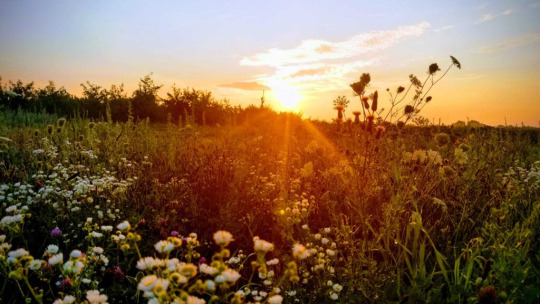
Previous studies have demonstrated that habitat factors can directly influence both an animal’s nutritional status and the strength of its immune system, which in turn can influence its susceptibility to pathogens. For example, Eurasian red squirrels living in fragmented habitats host greater gastrointestinal parasite burdens than those living in continuous forest habitats.
To get to the root cause of their Michigan bee observations, Fearon and her co-authors generated models allowing them to rigorously disentangle the effects of habitat characteristics on patterns of pathogen prevalence.
They reexamined the previously collected bee data and added new information about local and landscape-level habitat. For the study, the researchers defined high-quality bee habitat as areas that provide sufficient quantity and diversity of floral resources (both pollen and nectar) to sustain good pollinator nutrition.
At the local level, floral richness (meaning flower species diversity) and floral density were the key indicators of high-quality habitat. At the landscape level, proportion of “natural areas” surrounding farm fields and landscape richness (meaning areas with more land cover types) were the key characteristics. Natural areas included deciduous, evergreen and mixed forest; herbaceous and woody wetland; shrubland; grass pasture; and wildflower meadow.
Read the full article here: University Michigan News
Source: University of Michigan News Office of the Vice President for Communications
#pollinators#pollination#environmental education#environmental activism#protectourplanet#protect our children#savethebees#savethefuture
0 notes
Text
Journal 3
Even after reading the 2 articles and video provided in the assignment instructions, I learned more about Six Mile Cypress than I knew before. I find it very inspiring that even though this preserve is not the most famous or known worldwide there is a group of people, Friends of Six Mile Cypress, that are willing to work hard for the conservation of this land for the current and future generations. I also noticed at the bottom of the Lee County website that Six Mile currently has railroad track that were once used to transport military supplies to Buckingham Army Airfield during WWII, which I found interesting.

We began our trip in the learning a little more about the slough in the welcome center. Where we learned that the preserve is over 70 years old and covers over 3,000 acres and has 1.2 miles worth of boardwalk. To me this was surprising because I always thought that it was much smaller than that. And that it also acts home for many of Florida's unique species such as otters.
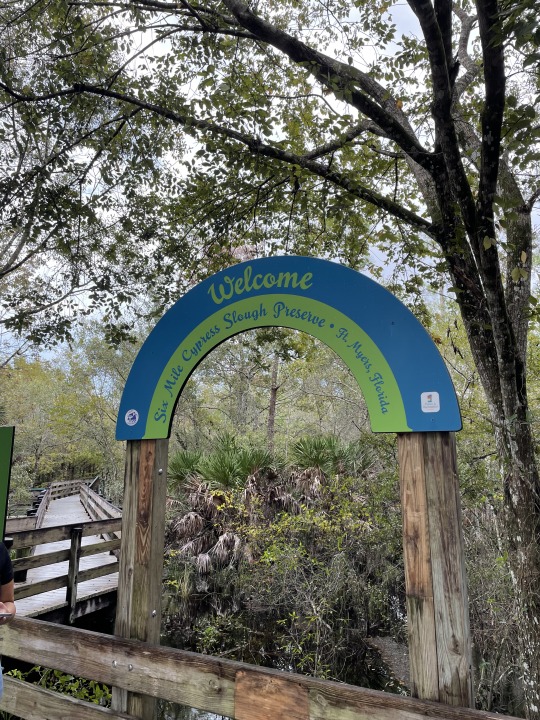
Our first stop on the tour was at Gator Lake. At the lake we all sat under the roof of the amphitheater and talked about the difference between a slough and a swamp/marsh. A slough has water that is constantly flowing through it in one direction whereas a swamp or mash where the water is stagnant. We also discussed the process of cypress trees helping to filter the water that is flowing through their trunks which then works its way down through the limestone into aquifers. There was also a power quote from Chief Seattle that read, “We don’t inherit the Earth from our ancestors, we borrow it from our children.” Which is a coincidence because we had read a letter from Chief Seattle just a few days before in class about treating the land with respect for future generations. Below is me on the dock that overlooks Gator Lake.
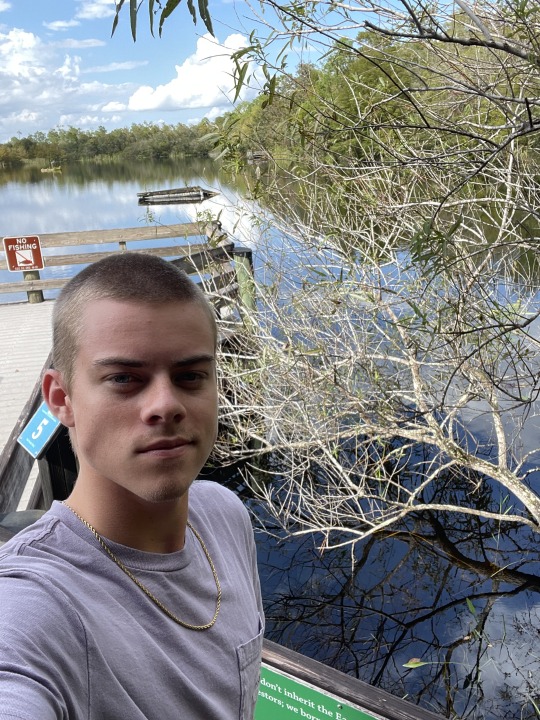
Our next stop was at Wood Duck Pond, while at the pond we learned about more about epiphytes. Which we had discussed in the field trip before our guide pointed out many of the epiphytes that were in eyesight but one in particular piqued my curiosity, the resurrection fern. The resurrection fern can decrease it’s need for by up to 97% when there is a severe drought. It will shrivel up and turn a brown grayish color and appear to be dead, but as soon the rain comes it sprouts right back to a healthy vibrant green, hence its name. And as we were leaving Wood Duck Pond there was a small alligator, no older than a few months, blocking our boardwalk. I wish I could’ve gotten a picture of the little guy but he scurried away too quick.
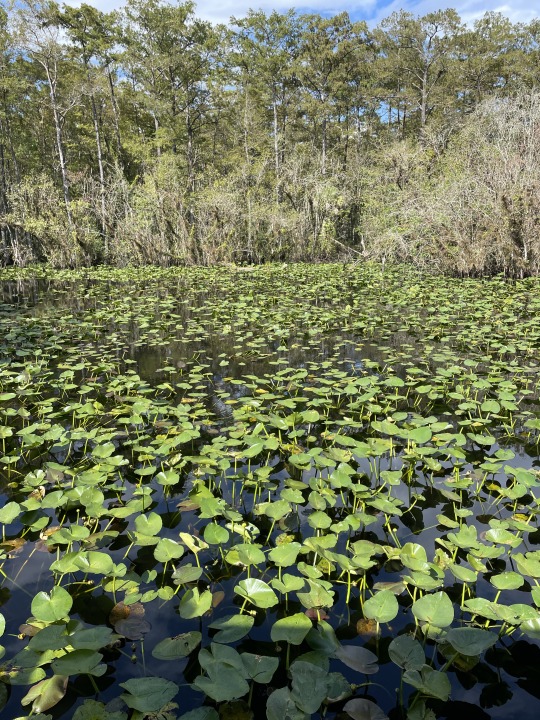
Our third stop on this trip was at Otter Pond, which as I’m sure you could guess is named after the many otters that have been spotted there. Although we were not lucky enough to see an otter that day we did see a few large Florida Gar. A long slender fish that almost looks like it has a screwdriver for a mouth. I had not seen ones this big in years so it was very cool to be able to see these native fish grow so big. At Otter Pond we also further discussed the many ways that these native plants help clean the air around us. For example, the grey mossy spots we see on the trunks of trees is actually called Lichen and is not only harmless to the tree but also cleans the air from carbon dioxide. Lichen even comes in many varying color including a bright red Lichen, nicknamed Blood lichen.

And lastly our final stop at Six Mile Cypress Slough Preserve was at Pop Ash Pond. Pop Ash Pond is classified as a Cypress dome which was also part of our earlier field trip through the trails at FGCU. While we were at our last stop we were all standing a large covered area and around the three walls of the structure was pictures and details about many of the native birds, animals, and fish that you may find during your trip there. It was really mind blowing to see how much biodiversity there was in just this small portion of land, and really shows you that we as population need to be better when it comes to preserving pieces of land like this.

Everyone should be dedicated to the conservation of this slough not only because of it’s natural beauty and its astonishing flora and fauna, but because the work that goes on here directly effects us all. Six Mile Slough acts as a natural water filter, it helps filter out debris and make sure the water arrives to Bonita Bay clean. Which means if this preserve is not there a large amount of water ending up on our ocean would be polluted and tainted by our own fault. The biggest threat to this park would be the infringing human presence and as the long as southwest Florida remains this popular each year we will get closer to seeing it go under. This trip definitely taught me a lot about our ecological imprint and sustainability. The fact that we were only mere minutes from I-75, a major freeway, and there was whole other world that seemed to almost be in another time and world makes me want to do everything I can to decrease my ecological footprint and help to save and preserve places like these for others who have not yet had the ability to see it’s beauty.
0 notes
Text
Another word for things found in nature

The apparition of the word translating the idea of “nature” has been traced back by linguists in many languages: at least Latin (Pellicer, 1966 Rolston, 1997), ancient Greek (Benveniste, 1948) and Chinese (Zhang, 2011), but also some less widespread languages such as Finnish (Jämsä, 1999). As a conslusion, we compare the semantic clusters stemming from these analyses with the contemporary scientific vision of nature in conservation science, in order to see how this semantic diversity can be an obstacle or a chance for the global conservation of “nature”. Such ambiguity may constitute the very source of many raging debates among ecologists, such as the “balance of nature” debate (Simberloff, 2014) and many others. In this study, we analyze the origins and evolution of the word “nature” in European languages, from its ancient Greek equivalent to Latin and then to modern meanings, showing that this word, already deemed vague and ambiguous since its most ancient uses, overwhelmingly changed in meaning several times in its history, which is at the basis of its current vagueness and ambiguity. Moreover, some punctual studies showed that, as for “wilderness” (Callicott, 2000), the word “nature” does not always have a translation in other languages (Philippe Descola, 2005), or can embody different meanings within a language. Nevertheless, these works have already stressed out that the word “nature” is very difficult to define, and has gone through many changes of meaning during its history (Lenoble, 1969). Hence, studying the concept of “nature” itself and its relationship with practical objects and social projects is crucial for conservation sciences and derived policies: many linguists, philosophers, and historians have already shown that its meaning is far from being unified or self-evident (Larrère and Larrère, 2015), but such works have had little popularization in biological sciences so far. However, “nature” is not such an easy word, and it actually fits the definition of an abstract concept, hence a mental construction rather than a concrete notion, which is situated both historically and geographically, and needs definition in context (Ellen, 1996), just like what has been done about “wilderness” (Rolston III, 1997, Callicott & Nelson, 1998, Callicott, 2008a) or more recently about the idea of a “balance ” (Simberloff, 2014). Many close and successful new technical words have been born in the same lexical field, such as “ecosystem”, “biodiversity”, “biosphere”, and even “Gaia”, but none of them ever really supplanted “nature”, even in scientific literature, and it is still the title of one of the most important scientific journals. As scientific knowledge of nature is (and will always remain) incomplete, scientists have to rely on mental representations and theoretical concepts, but these must be identified as such, and clearly defined (Demeritt, 2002). However, the appealing concept of “nature” has never been really theorized during all this time, and has been used to name more and more diverse things, as well as their opposite, at the risk of becoming another meaningless panchreston (Simberloff, 2014). Intense debates, significant thinkers and prominent scientific advances have made this field one of the most important socially in contemporary science, having a strong influence on national and international politics. Since early whistle-blowers such as John Muir or Rachel Carson to the theorization of a whole scientific discipline coined as “conservation biology” (Soulé, 1985), the conservation of nature has reached both wide popular concern and scientific maturity. Since at least the 1970s, a wide scientific, political, and public consensus has emerged about the crucial necessity of “protecting nature” (Worster, 1994). Nature preservation ought to take into account this semantic diversity when proposing policies, integrating the relativity and potential inaccuracy of the currently dominating occidental definition. One of the main present occidental meanings of “nature”, designating what is opposed to humans, currently used in public policies, conservation science, or environmental ethics, hence appears rare and recent, and contradictory with most other visions of nature, including former European representations and contemporary foreign ones. It appears that this word aggregated successively different and sometimes conflicting meanings throughout its history. We examine here the origins, etymology, and historical semantics of this word and its different meanings in contemporary European languages. However, while nature preservation has become a major social concern, the idea of nature remains elusive. The idea of ‘nature’ is at the very core of science, considered as its flagship and deepest link with human societies.

0 notes
Text
what to do if you experience a serpent at home
People frequently get discouraged when a serpent is available in their home, right here are some tips in what you ought to do.
What occurs if you have a serpent inside your Brisbane residence or on your residential or commercial property, company college or work area?
Don't stress and anxiety, Joshs serpent catching and also moving services the areas in Brisbane, Ipswich, and Logan and all surrounding suburb, are offered 24 hr 7 days a week for serpent removal and relocation. Call our friendly snake catcher solution currently on 0474 826 129 for a Fast as well as Reliable Service.
Watch on the snake from a risk-free distance until our serpent catcher gets here, this helps the snake catcher obtain the snake as rapidly as feasible far from your residence. Maintain animals as well as individuals well away from the serpent.
We provide Eftpos centers that accept Debit as well as bank card. We are extremely specialist friendly snake catchers with a cost effective phone call out fee. Our Serpent Catcher Brisbane, Ipswich and also Logan are very experienced with over thirty years incorporated experience in the reptile field.
We are fully certified, insured and completely trained in first Aid in serpent bites. Our Accredited Serpent Catcher are passionate concerning servicing the general public as well as additionally securing our attractive snakes in Brisbane and also all surrounding Residential areas working 24/7 around the clock.
Truths: Did you Know?
The relevance of snakes: conservation and also protection
Some serpent species have actually come to be endangered due to land clearing for farming, metropolitan growth and also with the intro of animals such as domestic animals and also the cane toad. Keeping a high degree of biodiversity is crucial to all life on Earth, consisting of humans, as well as serpents are a vital part of that biodiversity. In Australia, we fail to remember that snakes and various other reptiles make up a considerable percentage of the middle-order predators that keep our natural communities working. Without them the numbers of target species would raise to unnatural degrees and the killers that eat serpents struggle to locate food.
In addition to all Australian animals, serpents are protected under the Nature Preservation Act 1992 as well as can not be eliminated or taken from the wild. Logan snake catchers -keeping in Queensland requires a license from Queensland Parks and Wildlife Solution. Just snakes reproduced in bondage by a licensed person can be bought.
Get in touch with our friendly Serpent catcher to safely get rid of and also move the snake for you. As throughout QLD serpents are protected species and it calls for a permit to remove them. Snakes are an all-natural part of the ecosystem and also play a part in keeping points balance. If you have seen a serpent in your yard or home.
-- Remain Clam
-- Keep Kid as well as animals away
-- Call our licensed snake catchers 0474 826 129.
-- Try and also maintain an eye on the serpent from a very safe range 4 meters away until Joshs snake capturing show up.
1 note
·
View note
Text
Journal #5: The Food Forest
Describe the significant aspects of the history of the Food Forest
Prior to the Food Forest’s establishment in 2011, the space that now holds the forest was an old gravel parking lot. Although FGCU had small, short-term gardens, students wanted to transform the parking lot into something more useful that would also reflect the school’s mission of sustainability. Student government was given $200,000 to start the Food Forest, along with numerous generous donations from local organizations from the area. Soon after, a sustainable food production with permaculture was created and is still in operation more than eleven years later.

How does the design of the food forest demonstrate a commitment of FGCU to environmental sustainability?
There was a lot of thought that went into the design of the Food Forest. The irrigation of the food forest is limited to only a handful of piping, and helps to conserve water and rely on the natural cycles of Florida’s weather (as well as manual labor). There was also thought put into the elevation of the Food Forest during its inception. Due to Florida’s natural landscape, it is easy to have the three different ecosystems in one space. The Food Forest is one of these places where differing levels of landscape help to mimic different plains and increase the opportunity for more biodiversity. There is also thought put into which plants are planted where. For example, one plant that offers shade in the summer mimics the winter season for another plant that is not native to Florida, and accustomed to cold summers.
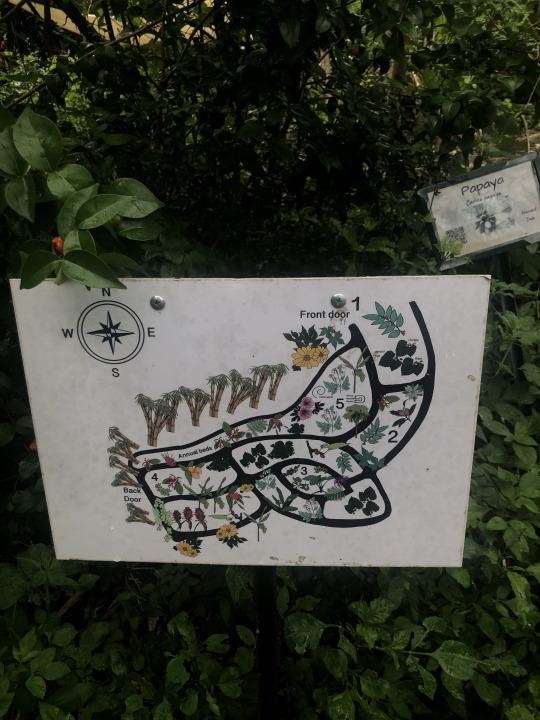
What is permaculture and why is it important/beneficial?
Permaculture is the practice of having multiple crops in one space, as opposed to harvesting rows and rows of the same crop. Permaculture offers a more ethical approach to farming and harvesting our crops, and creates more biodiversity to the ecosystems surrounding the crops as well. Permaculture is also self regulating, and leaves a significantly smaller footprint than monoculture crops often do, producing no waste and creating a more ecofriendly approach to harvesting.

Discuss some specific named invasive plants (and their significance) that you learned from on the field trip
The Food Forest has a few mulberry trees throughout the forest, with different species as well. However, the Mulberry is invasive to Florida. However, the way in which the plants have been planted within the forest complement each other’s needs. Thoughtful consideration of where to put the mulberry trees means that they have not been planted next to native plants that will be outcompeted by its roots.

What are the other learning experiences from this field trip?
I really liked how our guide showed us the different trees that you could take leaves from and chew on. I especially liked the one that smelled like cinnamon (even if we couldn’t eat that particular leaf). I also think it’s cool how the Food Forest has spices and herbs for students to pick from as well. I feel like it’s a really good way to support students and staff, and show everyone just how cool it can be to grow your own food and be more self-sustainable. Me and my roommate actually grow our own herbs as well. Our favorite is a basil plant we’ve been keeping in the dorm that we named Ingrid. I love walking over to our window and picking ten basil leaves to use in my dinner. It saves money, and prevents us from using more plastic that fresh herbs often come in.
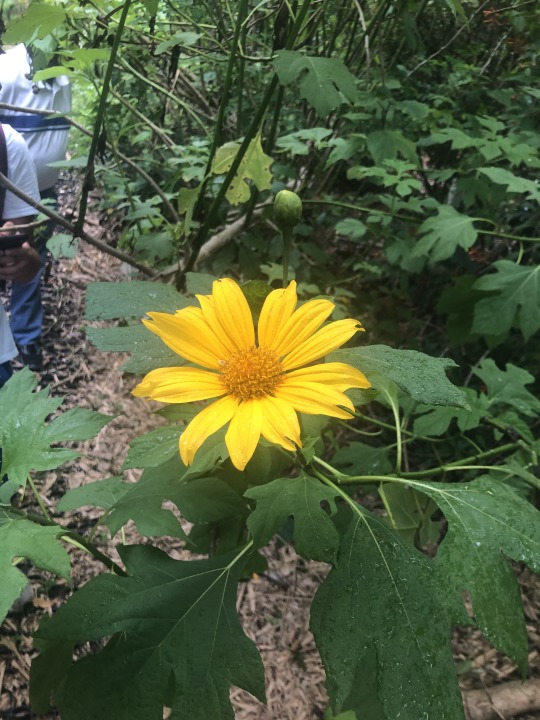
0 notes
Text
Cropland has gobbled up over 1 million square kilometers of Earth’s surface | Science


Farmland is surpassing much of the world. That’s the conclusion of a brand-new satellite map, which discovers that fields of corn, wheat, rice, and other crops have actually consumed up more than 1 million extra square kilometers of land over the previous 2 years.
The research study highlights how Earth’s land is ending up being, in essence, a unified international farm, with wealthier nations progressively contracting out crop production to poorer areas. Half of the brand-new fields have actually changed forests and other natural environments that saved big quantities of carbon, threatening efforts to save Earth’s progressively precarious biodiversity and prevent disastrous environment modification.
“The inexorable march of the human footprint is just brutal,” states research study author Matt Hansen, a geographer at the University of Maryland (UMD), College Park.
Many companies and federal governments map farmland in your area and regionally however getting an around the world view has showed hard. The Food and Agriculture Organization of the United Nations (FAO), for instance, assembles cropland data from member countries whose approaches and meanings differ commonly, yielding an irregular international photo.
To sew together a wider view, Hansen and coworkers mapped cropland utilizing information from the U.S. Geological Survey/NASA Landsat program, which has released a series of satellites created to continually keep track of the world’s surface. For years, the imagers have actually occasionally photographed every area on Earth with pixels approximately the size of baseball diamonds. Getting computer systems to acknowledge crop fields in satellite information provided difficulties, nevertheless, due to the fact that plants such as corn, rice, and soybeans look really various from one another. Fields likewise can be found in numerous sizes and shapes, and crops generally grow for just part of the year.
To validate and train the algorithms the scientists utilized to develop their map, they checked out farms around the globe and utilized high-resolution industrial satellite images readily available from Google, which are sharper than Landsat images however do not cover the whole world.
“The idea of the satellite is that we’re using a consistent signal, a consistent method,” Hansen states. “You can get a global story; you can also tell the story of [a single nation such as] Cambodia.”
The global cropland footprint increased 9% over the study period, which covered 2000 to 2019. The brand-new fields total up to approximately two times the location of Spain, and the boost is a number of times greater than FAO’s price quote of a 2.6% development in “arable land,” the authors report today in Nature Food. (FAO did not react to an ask for remark.)
South America led the world in relative cropland growth per acreage. That’s thanks mainly to a flourishing soybean market providing animals farmers in China and somewhere else, which improved the continent’s cropland by almost 50% throughout the research study duration. Meanwhile, Africa saw the biggest overall location of brand-new farm fields, many of which were developed to feed a fast-growing population. Forty percent of Africa’s cropland appeared in the previous 2 years, and the rate is speeding up.
Farmland likewise swelled in a number of South Asian countries and North America’s Great Plains. And although the conversion of rain forests like the Amazon to farming frequently gets the headings, brand-new crop fields took a larger bite out of less declared biodiversity locations, such as dry forests and savannas, states research study co-author Peter Potapov, likewise at UMD. In South America, for instance, essential dry environments called the Chaco and Cerrado took significant hits. “They will disappear completely very soon,” Potapov states.
When forests or savannas are transformed to farm fields, big quantities of carbon that was saved in trees and soil is frequently lost to the environment, speeding up environment modification. Such land cleaning triggers approximately one-eighth of human beings’ overall carbon emissions, scientists have actually approximated.
Crops didn’t make headway all over. In big swaths of the previous Soviet Union, for instance, farmers deserted ineffective locations. But the analysis reveals that at the international scale, even more cropland is being developed than deserted, states Tim Searchinger, a senior fellow at the World Resources Institute in Washington, D.C., who was not included with the work. This suggests, he states, that the carbon and biodiversity lost from natural environments is not being made up for by remediation of previous farmland somewhere else. Moreover, the analysis didn’t represent brand-new animals pastures and tree plantations, he keeps in mind, which can likewise ruin natural environments and trigger carbon emissions.
The research study did expose some enthusiastic patterns. The plant biomass development rate in croplands increased by 25%, and per capita crop location reduced by 10% over the research study duration, recommending humankind might be continuing to discover methods to squeeze more food out of an offered hectare. The scientists did not identify which crops grew where, nevertheless; they want to do that in the future.
The map is sharper and more up to date than numerous presently in usage, states Amy Molotoks, a geographer at the Stockholm Environment Institute. She and her coworkers “are highly likely to use it in the future” to identify where farming items are being grown on farms that have actually changed forests or other natural environments, she states.
To put the information into action, scientists will require to explain to customers how their food options drive farmland growth. As U.K. customers have actually discovered that big systems of South American forest are cleared to grow soybeans for animal feed, for instance, more have actually turned towards vegetarian and vegan diet plans, Molotoks notes.
And to avoid more land from being cleared for crops in Africa, researchers need to likewise assist farmers there produce even more food on land they presently farm, Searchinger includes; that continent’s crop yields are the world’s least expensive.
(*1*) Searchinger states.
New post published on: https://livescience.tech/2021/12/28/cropland-has-gobbled-up-over-1-million-square-kilometers-of-earths-surface-science/
0 notes